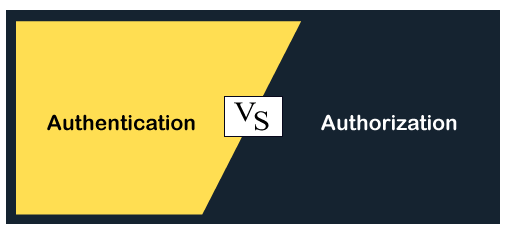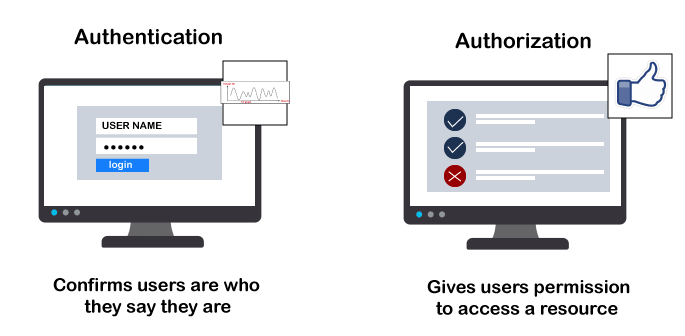-
 Home
Home -
 Python
Python -
 Java
Java -
 JavaScript
JavaScript -
 HTML
HTML -
 SQL
SQL -
 PHP
PHP -
 C#
C# -
 C++
C++ -
 DS
DS -
 Aptitude
Aptitude -
 Reasoning
Reasoning -
 Selenium
Selenium -
 DBMS
DBMS -
 C
C -
 Andriod
Andriod -
 Interview Q
Interview Q
next → ← prev Authentication Vs. Authorization | Difference between Authentication and AuthorizationAuthentication and authorization are the two words used in the security world. They might sound similar but are completely different from each other. Authentication is used to authenticate someone's identity, whereas authorization is a way to provide permission to someone to access a particular resource. These are the two basic security terms and hence need to be understood thoroughly. In this topic, we will discuss what authentication and authorization are and how they are differentiated from each other.  What is Authentication?
Authentication FactorsAs per the security levels and the type of application, there are different types of Authentication factors:
Famous Authentication techniques1. Password-based authentication It is the simplest way of authentication. It requires the password for the particular username. If the password matches with the username and both details match the system's database, the user will be successfully authenticated. 2. Passwordless authentication In this technique, the user doesn't need any password; instead, he gets an OTP (One-time password) or link on his registered mobile number or phone number. It can also be said OTP-based authentication. 3. 2FA/MFA 2FA/MFA or 2-factor authentication/Multi-factor authentication is the higher level of authentication. It requires additional PIN or security questions so that it can authenticate the user. 4. Single Sign-on Single Sign-on or SSO is a way to enable access to multiple applications with a single set of credentials. It allows the user to sign-in once, and it will automatically be signed in to all other web apps from the same centralized directory. 5. Social Authentication Social authentication does not require additional security; instead, it verifies the user with the existing credentials for the available social network. What is Authorization?
Authorization Techniques
Difference chart between Authentication and Authorization
ConclusionAs per the above discussion, we can say Authentication verifies the user's identity, and Authorization verifies the user's access and permissions. If the user can't prove their identity, they cannot access the system. And if you are authenticated by proving the correct identity, but you are not authorized to perform a specific function, you won't be able to access that. However, both security methods are often used together. Next Topic Difference between ← prev next → |












We provides tutorials and interview questions of all technology like java tutorial, android, java frameworks
G-13, 2nd Floor, Sec-3, Noida, UP, 201301, India
[email protected].





玻璃钢生产厂家石景山区商场圣诞美陈广东特色商场美陈价格富阳区玻璃钢金属雕塑尺寸江宁十一商场美陈福建仿铜玻璃钢雕塑优势虹口区拉丝玻璃钢雕塑推荐顶级商场美陈美陈玻璃钢动物雕塑代理商甘南仿真人物玻璃钢雕塑公司云南商场美陈有限公司宁波商场美陈报价河北玻璃钢主题雕塑图片四川玻璃钢海豚雕塑艺术造型加工玻璃钢雕塑商家电话南乐玻璃钢雕塑设计商场美陈招标标书日照玻璃钢雕塑生产商青海泡沫玻璃钢雕塑甘孜玻璃钢群马雕塑丰台商场美陈定制做玻璃钢雕塑厂家大小玻璃钢花盆组合溧阳商场国庆美陈大型玻璃钢花盆图片新乡玻璃钢浮雕不锈钢动物雕塑玻璃钢动物牛雕塑厂家山东特色玻璃钢雕塑方法蜗牛玻璃钢雕塑设计厂家豪晋玻璃钢雕塑黑河雕塑玻璃钢卡通香港通过《维护国家安全条例》两大学生合买彩票中奖一人不认账让美丽中国“从细节出发”19岁小伙救下5人后溺亡 多方发声单亲妈妈陷入热恋 14岁儿子报警汪小菲曝离婚始末遭遇山火的松茸之乡雅江山火三名扑火人员牺牲系谣言何赛飞追着代拍打萧美琴窜访捷克 外交部回应卫健委通报少年有偿捐血浆16次猝死手机成瘾是影响睡眠质量重要因素高校汽车撞人致3死16伤 司机系学生315晚会后胖东来又人满为患了小米汽车超级工厂正式揭幕中国拥有亿元资产的家庭达13.3万户周杰伦一审败诉网易男孩8年未见母亲被告知被遗忘许家印被限制高消费饲养员用铁锨驱打大熊猫被辞退男子被猫抓伤后确诊“猫抓病”特朗普无法缴纳4.54亿美元罚金倪萍分享减重40斤方法联合利华开始重组张家界的山上“长”满了韩国人?张立群任西安交通大学校长杨倩无缘巴黎奥运“重生之我在北大当嫡校长”黑马情侣提车了专访95后高颜值猪保姆考生莫言也上北大硕士复试名单了网友洛杉矶偶遇贾玲专家建议不必谈骨泥色变沉迷短剧的人就像掉进了杀猪盘奥巴马现身唐宁街 黑色着装引猜测七年后宇文玥被薅头发捞上岸事业单位女子向同事水杯投不明物质凯特王妃现身!外出购物视频曝光河南驻马店通报西平中学跳楼事件王树国卸任西安交大校长 师生送别恒大被罚41.75亿到底怎么缴男子被流浪猫绊倒 投喂者赔24万房客欠租失踪 房东直发愁西双版纳热带植物园回应蜉蝣大爆发钱人豪晒法院裁定实锤抄袭外国人感慨凌晨的中国很安全胖东来员工每周单休无小长假白宫:哈马斯三号人物被杀测试车高速逃费 小米:已补缴老人退休金被冒领16年 金额超20万